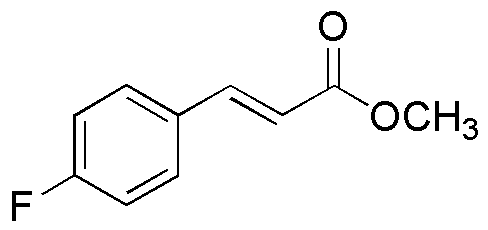Methyl 4-fluorocinnamate is widely utilized in research focused on:
- Pharmaceutical Development: This compound serves as an important intermediate in the synthesis of various pharmaceuticals, particularly in the development of anti-inflammatory and analgesic agents.
- Aromatic Compounds: It is used in the production of aromatic compounds, enhancing the flavor and fragrance industry by providing unique scent profiles.
- Polymer Chemistry: Methyl 4-fluorocinnamate is employed in the formulation of specialty polymers, offering improved thermal stability and mechanical properties compared to traditional compounds.
- Research in Organic Synthesis: Researchers utilize this compound in organic synthesis to create complex molecules, benefiting from its reactivity and functional group compatibility.
- Cosmetic Applications: It finds use in cosmetic formulations, where it acts as a skin-conditioning agent, providing enhanced texture and absorption in skincare products.
General Information
Properties
Safety and Regulations
Applications
Methyl 4-fluorocinnamate is widely utilized in research focused on:
- Pharmaceutical Development: This compound serves as an important intermediate in the synthesis of various pharmaceuticals, particularly in the development of anti-inflammatory and analgesic agents.
- Aromatic Compounds: It is used in the production of aromatic compounds, enhancing the flavor and fragrance industry by providing unique scent profiles.
- Polymer Chemistry: Methyl 4-fluorocinnamate is employed in the formulation of specialty polymers, offering improved thermal stability and mechanical properties compared to traditional compounds.
- Research in Organic Synthesis: Researchers utilize this compound in organic synthesis to create complex molecules, benefiting from its reactivity and functional group compatibility.
- Cosmetic Applications: It finds use in cosmetic formulations, where it acts as a skin-conditioning agent, providing enhanced texture and absorption in skincare products.
Documents
Safety Data Sheets (SDS)
The SDS provides comprehensive safety information on handling, storage, and disposal of the product.
Product Specification (PS)
The PS provides a comprehensive breakdown of the product’s properties, including chemical composition, physical state, purity, and storage requirements. It also details acceptable quality ranges and the product's intended applications.
Certificates of Analysis (COA)
Search for Certificates of Analysis (COA) by entering the products Lot Number. Lot and Batch Numbers can be found on a product’s label following the words ‘Lot’ or ‘Batch’.
Numéro de catalogue
Numéro de lot/série
Certificates Of Origin (COO)
This COO confirms the country where the product was manufactured, and also details the materials and components used in it and whether it is derived from natural, synthetic, or other specific sources. This certificate may be required for customs, trade, and regulatory compliance.
Numéro de catalogue
Numéro de lot/série
Safety Data Sheets (SDS)
The SDS provides comprehensive safety information on handling, storage, and disposal of the product.
DownloadProduct Specification (PS)
The PS provides a comprehensive breakdown of the product’s properties, including chemical composition, physical state, purity, and storage requirements. It also details acceptable quality ranges and the product's intended applications.
DownloadCertificates of Analysis (COA)
Search for Certificates of Analysis (COA) by entering the products Lot Number. Lot and Batch Numbers can be found on a product’s label following the words ‘Lot’ or ‘Batch’.
Numéro de catalogue
Numéro de lot/série
Certificates Of Origin (COO)
This COO confirms the country where the product was manufactured, and also details the materials and components used in it and whether it is derived from natural, synthetic, or other specific sources. This certificate may be required for customs, trade, and regulatory compliance.


